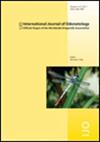Dragonfly flight: morphology, performance and behaviour
IF 1
4区 农林科学
Q3 ENTOMOLOGY
引用次数: 12
Abstract
Odonata flight performance capabilities and behaviour and their body and wing form diversity are explored, and their interrelationships discussed theoretically and from observational evidence. Overall size and particularly wing loading appear predictably to be related to speed range. In Anisoptera at least, relatively short bodies and long wings should favour high speed manoeuvrability, though further information is needed. Medium and low aspect ratio wings are associated with gliding and soaring, but the significance of aspect ratio in flapping flight is less straightforward, and much depends on kinematics. Narrow wing bases, petiolation, basal vein fusion, distal concentration of area and a proximally positioned nodus – described by a newly defined variable, the “nodal index” – all allow high torsion between half-strokes and favour habitually slow flight, while broad wing bases are useful at higher speeds. The “basal complex” in all families seems to be a mechanism for automatic lowering of the trailing edge and maintenance of an effective angle of attack, but the relative merits of different configurations are not yet clear. There is serious need for more quantitative information on a wider range of species and families.蜻蜓飞行:形态、性能和行为
探讨了蜻蜓的飞行性能、能力和行为以及它们的身体和翅膀形式的多样性,并从理论和观察证据中讨论了它们之间的相互关系。总体尺寸,特别是机翼载荷似乎与速度范围有关。至少在异翅目昆虫中,相对较短的身体和较长的翅膀应该有利于高速机动,尽管还需要进一步的信息。中低展弦比翼与滑翔和翱翔有关,但展弦比在扑翼飞行中的意义却不那么直接,更多地取决于运动学。窄翼基、叶柄、基底静脉融合、远端区域集中和近端定位结节——由一个新定义的变量“节点指数”描述——都允许在半划之间产生高扭转,有利于习惯性的慢速飞行,而宽翼基在高速飞行时有用。所有科的“基底复合体”似乎都是一种自动降低尾缘和维持有效攻角的机制,但不同构型的相对优点尚不清楚。迫切需要更多关于更广泛的物种和科的定量资料。
本文章由计算机程序翻译,如有差异,请以英文原文为准。
求助全文
约1分钟内获得全文
求助全文
来源期刊

International Journal of Odonatology
ENTOMOLOGY-
CiteScore
2.30
自引率
0.00%
发文量
15
审稿时长
>12 weeks
期刊介绍:
International Journal of Odonatology (IJO) is aimed at providing a publication outlet for the growing number of students of Odonata. It will address subjects such as the ecology, ethology, physiology, genetics, taxonomy, phylogeny and geographic distribution of species. Reviews will be by invitation, but authors who plan to write a review on a subject of interest to the journal are encouraged to contact the editor.
 求助内容:
求助内容: 应助结果提醒方式:
应助结果提醒方式:


